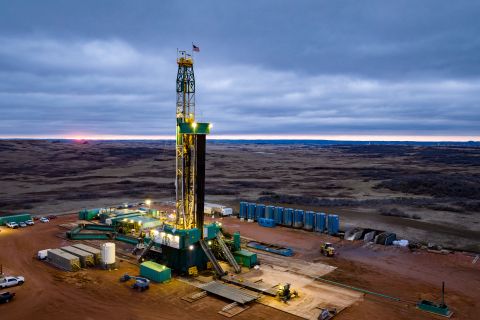"Deal volume on cash transactions has slowed somewhat over last year," says Mark McMurray, a principal with Calgary-based divestment firm Kobayashi Partners Ltd. "We see a lot of cautious optimism because of pricing with both oil and gas prices. There is caution on the oil curve because it's on a high and caution on the gas curve because it's on a low.
"People are waiting to see stable pricing on oil and some recovery on gas moving into the winter months ahead. Optimism keeps M&A activity moving, but caution keeps buyers out of the ditches."
George Gosbee, chairman, president and chief executive of Calgary-based investment-banker and asset-broker Tristone Capital Inc., predicts more transactions will occur as soon as buyers and sellers in Canada start seeing eye-to-eye. "The buyers and sellers are so far apart right now," he says. "The buyers want the price of assets to reflect current gas prices, but sellers' expectations are still at yesterday's valuations.
"A lot of transactions were put on hold once gas prices started dropping. Companies pulled in the reins to see what gas prices were going to do before they decided whether or not to sell. They're waiting to see if there is going to be a gas turnaround story."
M&A decision-makers are waiting to see if they will be able to find another property to replace the one they're thinking of selling. "It's becoming increasingly difficult to replace reserves and production, so a lot of companies are hesitant to rationalize their portfolios until they're able to acquire something," says Brent Heinz, vice president, Calgary-based Sayer Energy Advisors.
"This results in a shortage of supply in the Canadian acquisition and divestiture market. While there are some large packages of assets currently on the market, a limited number of buyers are able to bid on such large packages. Consequently, there remains a large demand for smaller-size acquisitions."
The average price paid for properties in Canada so far this year has been less than was being paid at the end of 2005, dropping to about C$60,000 per flowing barrel, McMurray says.
"This drop in the flowing-barrel metric has been driven by erosion in gas prices and the uncertainty about their recovery in the near and medium term," he says. "When we have to hope we'll have an active hurricane season or a warmer summer to draw down storage capacity, 'hope' is not a buying strategy."
 Companies are also reluctant to sell oil properties: most could not shoulder the loss of high-oil-price cash flow on top of the loss resulting from lower gas prices. "Oil prices are up, so why would a company want to sell its oil-producing properties when oil is the engine funding companies' capital programs? All the heavy-lifting is being done by oil properties right now," McMurray says.
Companies are also reluctant to sell oil properties: most could not shoulder the loss of high-oil-price cash flow on top of the loss resulting from lower gas prices. "Oil prices are up, so why would a company want to sell its oil-producing properties when oil is the engine funding companies' capital programs? All the heavy-lifting is being done by oil properties right now," McMurray says. The large amount of equity raised among Canada producers last year allowed most to enter 2006 with robust balance sheets. "Despite gas prices, most companies still have healthy balance sheets," says Gosbee. "They scaled back their capital expenditure programs once they saw gas prices start to go down and they raised a ton of equity last year."
More than C$88 billion was raised by the Canadian energy trusts and junior producers in 2005, he says. "Although they represent just 1% of the world's production, they raised 15% of all the capital in global equity issuances for the entire equity sector. The gas-price environment could stay like this all year and I still don't think we would see any financial-distress sales."
Replacing production is still a necessity for any publicly held company, so with a dearth of assets available for friendly purchase, some producers are attempting hostile takeovers. Unsolicited offers for SignalEnergy Inc. and Canada Southern Petroleum raised eyebrows in the Canadian M&A sector. The unsolicited bid for Canada Southern even ignited a bidding war between Petro-Canada and Canadian Oilsands, with Canadian Superior Energy entering a bid as well.
"In a pricing environment such as the one we're in now, the strong companies can launch an offer for the weak companies and know they're getting a good value," McMurray says. "Down cycles are always when hostiles are initiated. But typically, the party that launches the offer is unsuccessful. The hostile bid usually just puts the deal opportunity in play and is a catalyst to get something resolved with an undervalued company."
In each hostile takeover attempt to date, the target's assets were extremely strategic to the bidder. "We probably won't see many more hostile takeovers," says John Koyanagi, managing director, Canaccord Enermarket. "Given the Calgary business community and relationships, the transactions can be achieved in other ways. Generally, people here can still get a deal done without going the unsolicited route."
 Energy trusts
Energy trusts The trusts have simply begun combining, and on a friendly basis. "The requirement to maintain unit-holder distributions in a maturing basin, without significant exploration activity, will inevitably lead to a proliferation in corporate activity," reports U.K.-based energy-research firm Wood Mackenzie.
The most significant combination is that of Penn West and Petrofund. With production of 135,000 barrels of oil equivalent (BOE) per day and proved-plus-probable reserves of 515 million BOE, the pair is now the largest trust in Canada.
"Trust mergers are a significant trend right now," says Art Korpach, Calgary-based vice chairman and head of global oil and gas for CIBC World Markets. "They are driven by the fact that size is becoming more important in order for trusts to stay competitive.
"At the peak of the trust craze, the marketplace had 37 conventional oil and gas trusts. It probably doesn't need that many. So it also supports merging up the smaller trusts. It's logical that we'll see more of that occurring as a continued trend the rest of the year."
Martin Peters, managing director, Canaccord Enermarket, says the trusts will have to continue to combine as falling gas prices affect their distributions and larger trusts are accessing capital at a lower cost than the smaller trusts can.
"The trusts were en vogue last year, but they really aren't this year," Peters says. "Rising interest rates have put a damper on the attractiveness of the trusts. Gas is a big commodity for most of the trusts, and gas has slipped this year. That has put a lot of pressure on distributions. This year has been the first time some of the gas-focused trusts have had to cut their distributions."
Koyanagi was surprised by the Penn West-Petrofund combination. "I thought we would see some consolidations among the smaller trusts, but I have been surprised by the combination of the larger trusts," he says. "I didn't think the larger trusts would be involved just yet."
Gosbee predicts the balance of 2006 will see the smaller trusts continuing to combine. "Managing a bigger trust just becomes more difficult, especially once you get above the C$4-billion asset value," he says. "But the combination of Penn West and Petrofund made sense because the assets were a good fit and the management wanted to do something else."
U.S. divestments
The only spice in an otherwise barren Canadian marketplace so far this year has been the announcements of exits by U.S. companies in the form of two stellar asset packages offered by ConocoPhillips and Anadarko Petroleum Corp.
ConocoPhillips' assets are in Saskatchewan, Alberta and British Columbia. Total production is some 20,000 BOE per day, Heinz says. Anadarko's sale includes its Canadian operations in Alberta, Saskatchewan, British Columbia and the Northwest Territories. The assets have daily production of some 70,000 BOE per day.
"The announcement of the Anadarko Canada sale is one of the highest-quality collections of interests the marketplace has seen since the consolidation of the mid- to late 1990s," McMurray says. "Even if it were to be broken down into multiple packages, it would still be a great acquisition opportunity. It's a portfolio of assets without a lot of deficiencies and that makes it unique."
These exits by U.S. companies might not be the last in the Canadian M&A space this year. "We'll continue to see U.S. companies selling out of Canada," Tristone's Gosbee says. "The U.S. will continue to monetize its assets in Canada because it's a very competitive basin. The U.S. companies' cost of capital is good, but it doesn't compare with the trusts' cost of capital. I don't blame the U.S. companies for leaving. I wouldn't want to be here if I were a U.S. company."
Attracting and retaining employees-particularly in the oil-sands business-is also challenging today. "The oil sands have been a huge drain of human resources," Gosbee says. "It's getting harder and harder to retain guys. The oil sands have even affected other types of businesses because they recruit their workers and pay them better. It's rumored some of them have even had to shut down because they just can't keep enough employees."
Second-quarter results
Producers' second-quarter results were being prepared at press time, and many Canadian E&P observers didn't think the results will be encouraging. "We're all going to be surprised by the second-quarter reporting performance of the sector," McMurray says.
"It's been difficult this quarter because of the winter hang-over of the increasing costs of project operations, delays in production growth and increasing costs of services. If you superimpose the perfect storm of increased service costs, lower-than-expected production rates from marginal drilling success, and depressed gas prices, you get a second-quarter performance report that will disappoint a lot of investors."
Though larger companies will not feel the effects of lower natural gas prices and growing costs immediately, smaller companies may be forced to react quicker.
"The reality of lower gas prices has come to bear in the second quarter, particularly for the smaller companies," Koyanagi says. "There have been capital-expenditure program cuts, reduced activity and concerns over the leverage of balance sheets."
Most surprising to some about the impending announcements of negative second-quarter performances is that the companies didn't see a fall in gas prices coming.
"The fall of gas prices was so evident, I'm surprised more people didn't see it coming and get out," Gosbee says. "Lots of people were shocked that some of these companies were off 50%. If you can find willing sellers, it's a good time to buy gas in Canada right now."



Recommended Reading
E&P Highlights: Sept. 23, 2024
2024-09-23 - Here's a roundup of the latest E&P headlines, including Turkey receiving its first floating LNG platform and a partnership between SLB and Aramco.
Smart Tech Moves to the Hazardous Frontlines of Drilling
2024-10-08 - In the quest for efficiency and safety, companies such as Caterpillar are harnessing smart technology on drilling rigs to create a suite of technology that can interface old and new equipment.
Baker Hughes Defies Nature with an Upgrade to Ol’ Fashioned Cement
2024-10-15 - Baker Hughes’ InvictaSet uses regenerative capabilities to provide operators with a sustainable cement solution that can last for years.
Nabors Takes to Global Expansion in 3Q as Rig Count Shrinks in Lower 48
2024-10-25 - Nabors Industries saw broad growth across key international geographies in third-quarter 2024, with more rig deployments expected.
Seadrill to Adopt Oil States’ Offshore MPD Technology
2024-09-17 - As part of their collaboration, Seadrill will be adopting Oil States International’s managed pressure drilling integrated riser joints in its offshore drilling operations.
Comments
Add new comment
This conversation is moderated according to Hart Energy community rules. Please read the rules before joining the discussion. If you’re experiencing any technical problems, please contact our customer care team.





